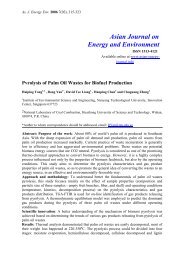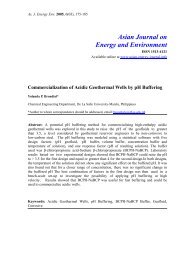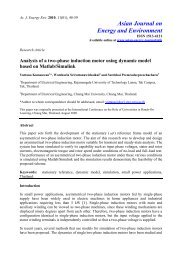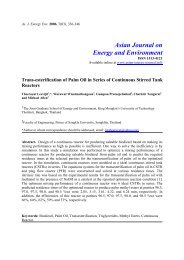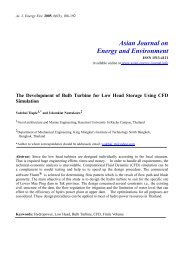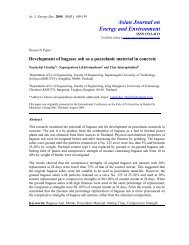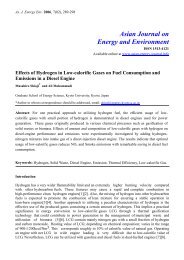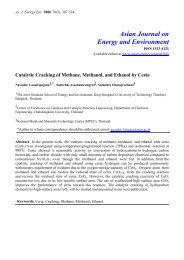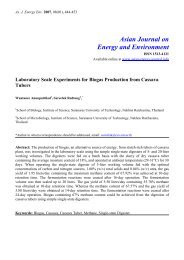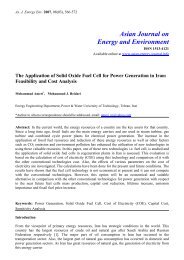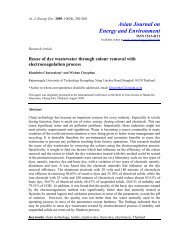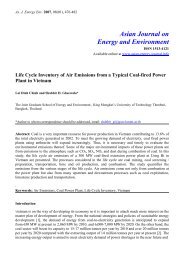A review on phytoremediation of heavy metals and utilisation of it s ...
A review on phytoremediation of heavy metals and utilisation of it s ...
A review on phytoremediation of heavy metals and utilisation of it s ...
Create successful ePaper yourself
Turn your PDF publications into a flip-book with our unique Google optimized e-Paper software.
As. J. Energy Env. 2005, 6(04), 214-231 218but the metal extracti<strong>on</strong> depends <strong>on</strong> <strong>it</strong>s bio available fracti<strong>on</strong> in soil. The advantages <strong>and</strong>disadvantages have been discussed in Table 2.Total <strong>and</strong> Bio-available fracti<strong>on</strong> <strong>of</strong> Heavy Metals in soilHeavy <strong>metals</strong> are elements having atomic weight between 63.54 <strong>and</strong> 200.59, <strong>and</strong> aspecific grav<strong>it</strong>y greater than 4 [35]. Trace amount <strong>of</strong> some <strong>heavy</strong> <strong>metals</strong> are required byliving organisms, however any excess amount <strong>of</strong> these <strong>metals</strong> can be detrimental to theorganisms [36]. N<strong>on</strong>essential Heavy <strong>metals</strong> include arsenic, antim<strong>on</strong>y, cadmium,chromium, mercury, lead, etc; these <strong>metals</strong> are <strong>of</strong> particular c<strong>on</strong>cern to surface water <strong>and</strong>soil polluti<strong>on</strong> [35]. Heavy <strong>metals</strong> exist in colloidal, i<strong>on</strong>ic, particulate <strong>and</strong> dissolved phase.Metals also have a high affin<strong>it</strong>y for humic acids, organo clays, <strong>and</strong> oxides coated w<strong>it</strong>horganic matter [37,38]. The soluble forms are generally i<strong>on</strong>s or uni<strong>on</strong>ised organometallicchelates or complexes. The solubil<strong>it</strong>y <strong>of</strong> <strong>metals</strong> in soil <strong>and</strong> groundwater is predominantlyc<strong>on</strong>trolled by pH [3,4,6] amount <strong>of</strong> metal [39], cati<strong>on</strong> exchange capac<strong>it</strong>y [40],organic carb<strong>on</strong> c<strong>on</strong>tent [37], the oxidati<strong>on</strong> state <strong>of</strong> the mineral comp<strong>on</strong>ents, <strong>and</strong>the redox potential <strong>of</strong> the system [38]. In general, soil pH seems to have the greatesteffect <strong>of</strong> any single factor <strong>on</strong> the solubil<strong>it</strong>y or retenti<strong>on</strong> <strong>of</strong> <strong>metals</strong> in soils. W<strong>it</strong>h a greaterretenti<strong>on</strong> <strong>and</strong> lower solubil<strong>it</strong>y <strong>of</strong> metal cati<strong>on</strong>s occurring at high soil pH [41]. Under theneutral to basic c<strong>on</strong>d<strong>it</strong>i<strong>on</strong>s typical <strong>of</strong> most soils, cati<strong>on</strong>ic <strong>metals</strong> are str<strong>on</strong>gly adsorbed <strong>on</strong>the clay fracti<strong>on</strong>s <strong>and</strong> can be adsorbed by hydrous oxides <strong>of</strong> ir<strong>on</strong>, aluminum, ormanganese present in soil minerals. Elevated salt c<strong>on</strong>centrati<strong>on</strong> creates increasedcompet<strong>it</strong>i<strong>on</strong> between cati<strong>on</strong>s <strong>and</strong> <strong>metals</strong> for binding s<strong>it</strong>es. Also compet<strong>it</strong>iveadsorpti<strong>on</strong> between various <strong>metals</strong> has been observed in experiments involvingvarious solids w<strong>it</strong>h oxide surfaces, in several experiments, Cd adsorpti<strong>on</strong> was decreased bythe add<strong>it</strong>i<strong>on</strong> <strong>of</strong> Pb or Cu [42].Table 2. Advantages <strong>and</strong> disadvantages <strong>of</strong> phytoremediati<strong>on</strong>.No Advantages Disadvantages / Lim<strong>it</strong>ati<strong>on</strong>s1Amendable to a variety <strong>of</strong> organic<strong>and</strong> inorganic compoundsRestricted to s<strong>it</strong>es w<strong>it</strong>h shallowc<strong>on</strong>taminati<strong>on</strong> w<strong>it</strong>hin rooting z<strong>on</strong>e <strong>of</strong>234567In S<strong>it</strong>u / Ex S<strong>it</strong>u Applicati<strong>on</strong> possiblew<strong>it</strong>h effluent/soil substraterespectively.In S<strong>it</strong>u applicati<strong>on</strong>s decrease theamount <strong>of</strong> soil disturbance comparedto c<strong>on</strong>venti<strong>on</strong>al methods.Reduces the amount <strong>of</strong> waste to bel<strong>and</strong>filled (up to 95%), can be furtherutilized as bio-ore <strong>of</strong> <strong>heavy</strong> <strong>metals</strong>.In S<strong>it</strong>u applicati<strong>on</strong>s decrease spread <strong>of</strong>c<strong>on</strong>taminant via air <strong>and</strong> water.Does not require expensiveequipment or highly specializedpers<strong>on</strong>nel.In large scale applicati<strong>on</strong>s thepotential energy stored can be utilizedto generate thermal energy.remediative plants.May take up to several years toremediate a c<strong>on</strong>taminated s<strong>it</strong>e.Restricted to s<strong>it</strong>es w<strong>it</strong>h lowc<strong>on</strong>taminant c<strong>on</strong>centrati<strong>on</strong>s.Harvested plant biomass fromphytoextracti<strong>on</strong> may be classified as ahazardous waste hence disposal shouldbe proper.Climatic c<strong>on</strong>d<strong>it</strong>i<strong>on</strong>s are a lim<strong>it</strong>ingfactorIntroducti<strong>on</strong> <strong>of</strong> n<strong>on</strong>native species mayaffect biodivers<strong>it</strong>yC<strong>on</strong>sumpti<strong>on</strong>/utilizati<strong>on</strong> <strong>of</strong>c<strong>on</strong>taminated plant biomass is a cause<strong>of</strong> c<strong>on</strong>cern.



